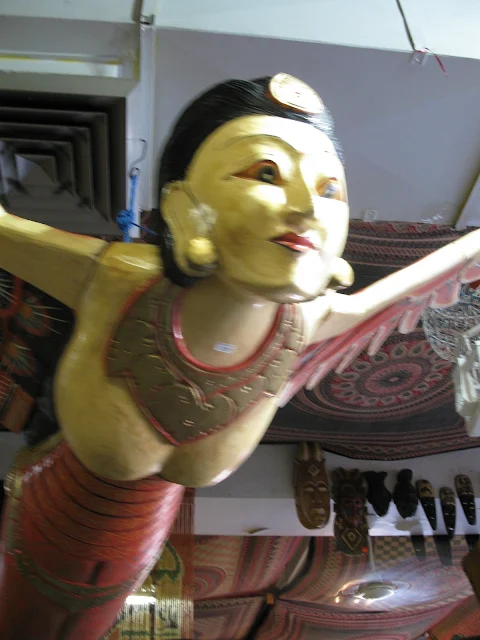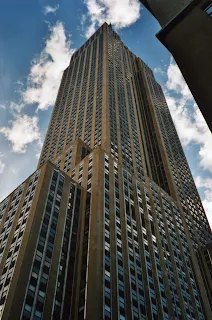
Wednesday, October 8, 2008
Tuesday, October 7, 2008
The Window at Natalie's Hat Shop on Decarie Boulevard, Montreal

The importance of this photo isn't evident in the photograph itself. Here it is: after my father died my mother purchased a new hat for the funeral at Natalie's Hat Shop facing Decarie Boulevard. The viewer couldn't have known this, which is, after all important to the reason why this photograph is included here. There is more to the story, including poems I wrote about the hat and what became of the hat. Also, that Natalie, the hat shop's owner, later lived at one of Hoolahan's flats on Oxford Avenue; in fact, she lived in the flat next to where we had formerly lived... so there is quite a bit of synchronisty to this.
Sunday, October 5, 2008
Saturday, October 4, 2008
Friday, October 3, 2008
Thursday, October 2, 2008
Notes on Photography (unrevised) Four
Alexis Nihon Plaza, solarium, 2013
21. The Observing Eye: What photographs reveal is what the eye (the consciousness of the photographer) finds of interest, observes, and pays attention to. This is the observed world of the photographer, it shows a consistent and cohesive vision of the world. It is the documentation of the observing eye.
22. Krishnamurti writes, “The content of consciousness is consciousness.” What is recorded in the photographs is the consciousness of the photographer.
23. A photograph records how a specific time and place is seen by the observing eye, photographs are the record of what is observed. In my photographs, I am aiming for an elegant austerity.
24. Krishnamurti writes, “The observer is the observed.” What you think you are observing turns out to be… yourself.
25. Whatever I photograph has a deeper, personal meaning for me; some of the most obscure photographs refer to an image or a line or phrase from one of my poems. So, “Between Chaston and Green” refers to where my father is buried; “Natalie’s hat shop on Decarie Boulevard” refers to where my mother purchased a hat to wear to my father’s funeral; and so on.
26. Artists have access to what the public knows little about but feels is important, has value, and wants: it is access to the unconscious mind.
27. Today, many people want to be artists. They want to publish their poems, they want to exhibit their drawings and photographs, they want to be creative. They want to fill the emptiness within themselves with their artistic expression, with their poems, their music, their photographs.
28. There is more to being an artist than creativity and talent, there is hard work, being alone, and an obsessive personality.
29. Why would anyone be as obsessed about death as I have been? or as consumed with the ancestors? or have taken so many photographs in cemeteries and churches? or have written obsessively about the same subjects, book after book, diary after diary, decade after decade?
30. It is necessary to speak one’s truth. I can say this with conviction, as someone who has always taught others not to censor their words, their vision. And yet, I have censored myself, I have held back what I wanted to say, I have doubted myself, been silenced by others, not wanted to offend or cause arguments, been too concerned that others not think badly of me and so remained silent. And yet, I have been happiest when I have spoken my truth; when I have not spoken my truth it has gotten me nowhere.
31. (from) Letters of Arthur Rimbaud:
… The first study for a man who wants to be a poet is the knowledge of himself, entire. He searches his soul, he inspects it, he tests it, he learns it. As soon as he knows it, he cultivates it: it seems simple: in very brain a natural development is accomplished; so many egoists proclaim themselves authors; others attribute their intellectual progress to themselves! But the soul has to be made monstrous, that’s the point:… Imagine a man planting and cultivating warts on his face… One must, I say, be a visionary, make oneself a visionary.
Wednesday, October 1, 2008
Tuesday, September 30, 2008
Monday, September 29, 2008
Blaise Cendrars Cut Up (two)
An old monk was
Novgorod.
And I, the bad poet who Still, I was a very bad poe
everywhere I couldn’t go to the end.
And also merchants still I was hungry
To go make their fortune And all the days and all
And all the shopwindows glasses
And all the houses and all I should have liked
And all the wheels of cabs and all the streets
pavements those lives
I should have liked to plus turning like whirlwinds over broken
nge them into a furnace of swords
the square
And my hands took fligh The great almonds of the
wings And the honeyed gold of
And those were the last An old monk was reading
Of the very last voyage I was thirsty
And of the sea. And I was deciphering
When, all at once, the pig
I was in Moscow, where too,
with the rustling of albatross flames
And I was not satisfied of the last day
that my eyes turned
Their train left every many dead out there
It was rumored there we rates
One took along a hundred accounts I the bank.
clocks from Blac Malmö filled with tin cans and cans
Another, hatboxes,
Revolution… omen
And the sun was a fierce hire which could also be useful
That burned like live
It was in the time of my And I should have liked
I was scarcely sixteen And tear out all the
And dissolve all those
garments that enrage
I could sense the coming
Cut up of “Prose of the Transsiberian and of Little Jeanne of France”, by Blaise Cendrar
Thursday, September 25, 2008
2226 Girouard Avenue, Montreal
Wednesday, September 24, 2008
Sunday, September 21, 2008
Blaise Cendrars Cut Up (one)
o grind up all the bones cathedrals all in white
the bells
all bodies, naked and strange under me the legend of Nizhni Novgorod
me…
of the great red Christ of the Russian letters
eons of the Holy Ghost flew up from
wound adolescence
I had already forgotten my birth
it was war
Love carted away millions of corpses
the last trains leaving
because they weren’t selling any ging to me the legend of Nizhni
going away would have liked to
didn’t want to go anywhere, could go
had enough money
corkscrews
Still another, coffins from I was trying to nourish myself with
of sardines in oil
Then there were many with the bell towers and the stations
Women with crotches for stars
Coffins
They were all patented day morning.
It was rumored there were many dead.
They traveled at reduced boxes of alarm clocks and cuckoo
And they had savings Forest
and an assortment of Sheffield
the women in the cafes and all In Siberia cannon
Hunger cold plague
them and break them And the muddy waters
In all the stations I saw
Nobody could
more tickets
And the soldiers who
stay. . .
______________________________
Cut up of “Prose of the Transsiberian and of Little Jeanne of France”, by Blaise Cendrar








.JPG)

































